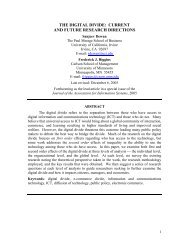When Should Software Firms Commercialize New Products ... - MISRC
When Should Software Firms Commercialize New Products ... - MISRC
When Should Software Firms Commercialize New Products ... - MISRC
Create successful ePaper yourself
Turn your PDF publications into a flip-book with our unique Google optimized e-Paper software.
ucts. First, software products nowadays are increasingly built using a modular architecture<br />
which, in turn, facilitates grouping, separating, or locking certain features. Second, it is<br />
relatively easytoembedinsoftwareprogramstrial-expiration clocksassociated withfeature-<br />
locking mechanisms. Third, software products are digital goods with negligible marginal<br />
reproduction cost, that can be provided in unlimited supply and can be “shipped” via rela-<br />
tively cheap online distribution channels. This way, absolutely all interested customers have<br />
access to the free consumption opportunities embedded in the freemium offering. Fourth,<br />
software products often belong to the category of experience goods. By trying (sampling)<br />
the product or part of it before committing to any purchase, consumers could learn more<br />
about the quality and other attributes (such as speed, functionality, and features) of the<br />
software, capabilities of related modules, compatibility issues, hardware requirements, etc.<br />
It remains largely unknown how well these freemium models fare, compared with con-<br />
ventional and well established business models. As illustrated by the examples above,<br />
freemium models are applied nowadays in both software-as-a-service markets as well as<br />
markets for software products characterized by a one-time purchase and designed to run<br />
autonomously on the consumers’ hardware. In this paper, we focus on the latter. Moti-<br />
vated by inquiries from entrepreneurs, we advance a unified multi-period framework that<br />
accounts for word-of-mouth effects and cross-module synergies and can capture the essence<br />
of several software business models, including freemium and seeding ones. We use this<br />
framework in particular to derive the equilibrium for each model and fully characterize<br />
conditions under which freemium models are superior to conventional charge-for-everything<br />
and seeding models. We further compare freemium models against each other. To the best<br />
of our knowledge, this represents the first extensive analytical benchmarking study that<br />
juxtaposes for-fee, freemium, and seeding models. Our results indicate that, while seeding<br />
models are always dominated, the conventional for-fee model and the freemium models can<br />
each be optimal in separate regions of the feasible space. We also address policy implica-<br />
tions by demonstrating that switching from conventional or seeding models to freemium<br />
models always increases social welfare. Matching welfare results with the profit analysis,<br />
we also explore cases when the firm should be subsidized (i.e., when the interests of the firm<br />
and the society are not well aligned).<br />
The rest of the paper is organized as follows. §2 presents a summary of the relevant<br />
literature. In §3, we introduce the general models. In §4, §5, and §6, we derive the optimal<br />
4
















